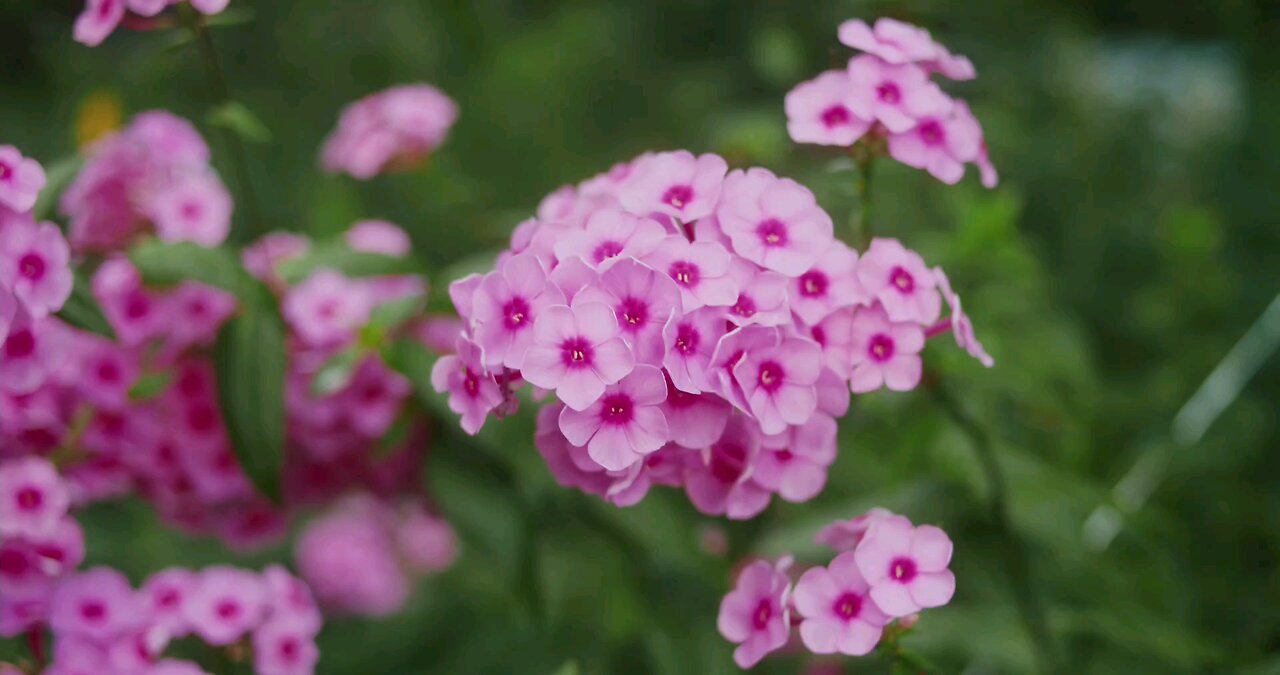Premium Only Content

"Pink Phlox Paniculata: Attracting Pollinators and Brightening Landscapes"
Phlox paniculata, commonly known as garden phlox or tall phlox, is a perennial flowering plant known for its vibrant, fragrant blooms. Pink phlox refers to varieties of this species that exhibit pink flowers. Here’s an overview:
Description:
Appearance: Phlox paniculata typically grows to a height of 2 to 4 feet (60 to 120 cm) and features sturdy stems that can support large clusters of flowers. The flowers are often star-shaped and can vary in color, with pink being one of the most popular varieties.
Leaves: The leaves are lance-shaped, dark green, and grow in opposite pairs along the stem. They can reach lengths of about 4 to 6 inches (10 to 15 cm).
Blooming Season: Pink phlox blooms from mid-summer to early fall, generally between July and September. The blossoms are known for their sweet fragrance, attracting pollinators like bees and butterflies.
Habitat and Distribution:
Native to eastern North America, Phlox paniculata typically grows in open woods, meadows, and along roadsides. It prefers well-drained, fertile soil and full sun to partial shade, thriving in USDA hardiness zones 4 to 8.
Cultivation:
Pink phlox is a popular choice for garden landscapes due to its vibrant colors and ability to attract pollinators. It is often used in borders, cottage gardens, and as a cut flower.
The plant prefers well-drained soil rich in organic matter. It is relatively low-maintenance, although regular watering is necessary during dry spells.
Deadheading spent flowers can promote longer blooming periods, and it is advisable to cut back the plants in the fall to maintain their health.
Ecological Importance:
Phlox paniculata is valuable for pollinators, providing nectar and pollen to bees, butterflies, and hummingbirds. Its blooms are an important food source during the summer months.
Uses:
In addition to its ornamental uses, pink phlox has been used in traditional medicine for various ailments, although it is primarily cultivated for its beauty in gardens.
Some cultivars of Phlox paniculata are resistant to powdery mildew, a common fungal disease that affects many garden phlox varieties.
Conclusion:
Pink Phlox paniculata is a stunning and fragrant addition to any garden, offering bright colors and attracting beneficial pollinators. Its hardiness and ease of care make it a favorite among gardeners looking to enhance their landscapes with vibrant blooms.
-
 10:02
10:02
MichaelBisping
15 hours agoBISPING: "Was FURY ROBBED?!" | Oleksandr Usyk vs Tyson Fury 2 INSTANT REACTION
12.5K7 -
 8:08
8:08
Guns & Gadgets 2nd Amendment News
2 days ago16 States Join Forces To Sue Firearm Manufacturers Out of Business - 1st Target = GLOCK
63K60 -
 10:17
10:17
Dermatologist Dr. Dustin Portela
1 day ago $12.40 earnedOlay Cleansing Melts: Dermatologist's Honest Review
85.8K5 -
 1:02:20
1:02:20
Trumpet Daily
2 days ago $31.29 earnedObama’s Fake World Comes Crashing Down - Trumpet Daily | Dec. 20, 2024
54.5K40 -
 6:29
6:29
BIG NEM
1 day agoCultivating God Mode: Ancient Taoist NoFap Practices
42.9K9 -
 30:53
30:53
Uncommon Sense In Current Times
2 days ago $9.36 earned"Pardon or Peril? How Biden’s Clemency Actions Could Backfire"
61.6K4 -
 40:01
40:01
CarlCrusher
22 hours agoSkinwalker Encounters in the Haunted Canyons of Magic Mesa - ep 4
57.6K3 -
 59:44
59:44
PMG
1 day ago $7.55 earned"BETRAYAL - Johnson's New Spending Bill EXPANDS COVID Plandemic Powers"
62.5K25 -
 6:48:50
6:48:50
Akademiks
20 hours agoKendrick Lamar and SZA disses Drake and BIG AK? HOLD UP! Diddy, Durk, JayZ update. Travis Hunter RUN
184K33 -
 11:45:14
11:45:14
Right Side Broadcasting Network
9 days agoLIVE REPLAY: TPUSA's America Fest Conference: Day Three - 12/21/24
367K28